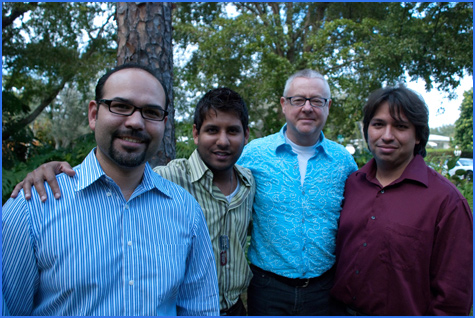South Beach Chamber Ensemble serves up enterprising program with notable premiere

The South Beach Chamber Ensemble performed music of Villa-Lobos, Pamela Marshall and Gilbert Kong Thursday night at the Coral Gables Museum.
The enterprising South Beach Chamber Ensemble presented an audacious program of string quartets by contemporary composers that included a world premiere and music by a 20th-century Latin American icon Thursday night at the Coral Gables Museum. Enhanced by the strongly resonant acoustic of the museum’s auditorium, the players offered finely honed performances.
The String Quartet No.1 (Truth Becoming) by Pamela Marshall was inspired by May Swenson’s poem The Process. Prior to the performance, soprano and voice teacher Anna Hersey read Swenson’s poetic synthesis of nature and sensuality.
Marshall, a graduate of Yale University and the Eastman School of Music, has fashioned a single movement, fifteen-minute score that matches the eclecticism of Swenson’s strophes. Opening with restless figurations suggestive of minimalism, the music turns darker as the first violin injects dissonant chords against the repetitive, energetic thematic cells. The score veers into atonality and a quiet, meditative stasis. Marshall has fashioned a strikingly effective work that eschews formulaic orthodoxy. Violist Rafael Ramirez, a member of the Miami Symphony and doctoral candidate at the UM Frost School of Music, was a standout for the rich tone and emotional depth of his solo passages.
The world premiere of Gilbert Kong’s Food, Shelter, Clothing marked the first score for string quartet by a promising young composer. Kong, a composition student of Fred de Sena at the New World School of the Arts, has created a three-movement work with a strongly emotional subtext.
Kong’s writing for strings is remarkably assured. The score opens with driving rhythmic fragments, offset by interludes of repose. A dark, moody cello solo intrudes on the surrounding relentless motion, recalling the angular lyricism of Walton’s chamber music. Plucked strings mark the second movement but these are not the playful pizzicatos of the Debussy or Ravel quartets. Turmoil and tragedy seem to lurk beneath the pulsations (though this elongated dramatic interlude would benefit from some tightening). Motoric rhythms propel the finale with contrasting fragmentary motifs contributing to the piece’s visceral impact. Kong is a gifted young composer and this first ambitious effort bodes well for future ventures.
The ensemble’s well-rehearsed performance brought the score’s strengths to the fore. Cellist Michael Andrews, founder of the group, was an adept, emphatic force in the featured cello part. Violinists Luis Fernandez and Anthony Seepersad brought boundless energy, stamina and bright tonal focus to the virtually nonstop violin writing.
Outside of Latin America, the music of Heitor Villa-Lobos is more revered than performed with the exception of several short pieces. His large-scale works, particularly the eleven symphonies and seventeen string quartets, deserve greater exposure. Refusing to embrace any of the opposing stylistic trends of the early twentieth century, Villa-Lobos fused a vibrant color palette of national influences with the harmonic and rhythmic force of European modernism. Neither radical nor avant-garde, Villa-Lobos’ musical voice remains uniquely original.
Props to the South Beach Chamber Ensemble for offering the Brazilian master’s String Quartet No. 5. This four-movement work, composed in 1931, has enough musical ideas for three scores. Jaunty Brazilian themes, hints of neo-Classicism, echoes of hazy impressionism and toe-tapping syncopation mix to delightful effect in the score’s opening movement. A solemn viola subject and eerie violin tremolos precede the expansive, throbbing romantic theme of cinematic proportions in the Vivo second movement. By turns languid and stirring, the brief Andantino forms a prelude to the brisk, edgy finale, suggesting Stravinsky at his most acerbic and biting.
Masterfully conceived, Villa-Lobos’ score should be in the repertoire of high-profile chamber groups. Except for some initial violin insecurity, Andrews and his colleagues gave a taut, intensely dedicated rendition of this fine score. After repeated curtain calls, the quartet repeated the brilliant final Allegro.
The South Beach Chamber Ensemble repeats the program 7:30 November 15 at the Miami Beach Botanical Garden, 2000 Convention Center Drive. 305-673-2183; sobechamberensemble.org.
Posted in Performances
4 Responses to “South Beach Chamber Ensemble serves up enterprising program with notable premiere”
Leave a Comment
Fri Nov 4, 2011
at 12:52 pm
4 Comments







Posted Nov 05, 2011 at 12:17 pm by Thomas Sleeper
Sounds like a terrific program and performance! Sorry that I missed it – but will make plans to hear their next event thanks to this review.
Thank you.
Posted Nov 05, 2011 at 12:48 pm by Maria A. Bermudez
The hard work is paying off. Very proud of these local artists. Congrats!
Posted Nov 06, 2011 at 2:13 pm by Eduardo Moros
My sincere congratulations to Rafael, a great student of music bound to be a Maestro!
Posted Nov 07, 2011 at 10:20 am by Pamela Marshall
Lawrence,
Thank you for the comments in your review. I’m so pleased to have South Beach Chamber Ensemble performing Truth Becoming again this season. Wonderful, expressive musicians who support us composers with their musicality and their interest in new-made music!